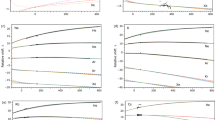Abstract
The general results regarding the symmetry of density matrices constructed from wave functions of a given symmetry species and the consequences for the transformation properties of the natural p-states reviewed in a previous communication [1] are illustrated for the special case p=1 for linear molecules with C ∞v - or D ∞h -symmetry. It is shown that even if the wave function belongs to a degenerate species, the natural orbitals (NO's) can always choosen to be adapted to the effective symmetry group C ∞ . The role played by the symmetry-adapted natural orbitals (SANO's) and of the “natural expansion” for 2-electron wave functions in this case is discussed.
Zusammenfassung
Die in einer früheren Arbeit [1] zusammengestellten Ergebnisse über das Symmetrieverhalten reduzierter Dichtematrizen, die aus Wellenfunktionen bestimmter Symmetrie konstruiert sind, sowie die Transformationseigenschaften der „natürlichen p-Zustände“ werden am Beispiel von linearen Molekülen mit C ∞v - oder D ∞h -Symmetrie für den Fall p=1 illustriert. Es wird gezeigt, daß auch dann, wenn die Wellenfunktion zu einer entarteten Symmetriespecies gehört, die natürlichen Orbitale (NO's) der effectiven Symmetriegruppe C ∞ adaptiert sind.Die Rolle, die in diesem Fall die symmetrieadaptierten natürlichen Orbitale (SANO's) und die „natürliche Entwicklung“ von 2-Elektronenwellenfunktionen spielen, werden diskutiert.
Résumé
Les résultats généraux recensés dans une communication précédente [1] concernant la symétrie des matrices densités construites à partir de fonctions d'onde de symétrie donnée et ses conséquences sur les propriétés de transformation des états -p naturels, sont illustrés sur le cas spécial où p=1 dans les molécules linéaires à symétrie C ∞v ou D ∞h . On montre que même si la fonction d'onde appartient à une catégorie dégénérée, les orbitales naturelles (NO's) peuvent toujours être choisies pour être adaptées au groupe de symétrie effectif C ∞ . On discute le rôle joué par les orbitales naturelles adaptées à la symétrie (SANO's) et “l'expansion naturelle” des fonctions d'onde à deux électrons.
Similar content being viewed by others
References
Bingel, W. A., Kutzelnigg, W.: Adv. in Quantum Chemistry, Vol. 5 (1969).
Coleman, A. J.: Rev. mod. Physics 35, 668 (1963).
Löwdin, P. O.: Physic. Rev. 97, 1474 (1955).
—, Shull, H.: Physic. Rev. 101, 1730 (1956).
Rothenberg, S., Davidson, E. D.: J. chem. Physics 45, 2560 (1966); see also Gabel, B.: Diplomarbeit, Göttingen (1969).
Bender, C. F., Davidson, E. R.: J. chem. Physics 47, 360 (1967); HF.
Chan, A. C. H., Davidson, E. R.: J. chem. Physics 49, 727 (1968); BeH.
Brown, R. E., Shull, H.: Int. J. quant. Chem. 2, 663 (1968); LiH.
Konowalow, D. D., Barker, W. H., Mandel, R.: J. chem. Physics 49, 5137 (1968); H2.
Lyon, W. D., Hirschfelder, J. O.: J. chem. Physics 46, 1788 (1967); H2, Li2, F2.
Messmer, R. P., Fraga, S.: Techn. Report Alberty TC 6704 (1967); H2, He 2+2 , and other diatomics, σ-NO's only.
Author information
Authors and Affiliations
Rights and permissions
About this article
Cite this article
Bingel, W.A. The symmetry behaviour of the first-order density matrix and its natural orbitals for linear molecules. Theoret. Chim. Acta 16, 319–330 (1970). https://doi.org/10.1007/BF00527080
Received:
Issue Date:
DOI: https://doi.org/10.1007/BF00527080




